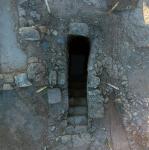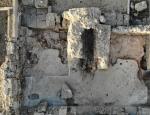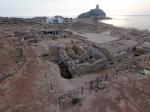Summary (English)
During this campaign, the team from Milan University continued the excavation, study and work to enhance a large sector of Area E, situated between the theatre and Su Coloru point.
Excavation took place in the Central Baths, the House of Director Tronchetti, the House of the Well and the central part of the House of the Tetrastyle Atrium.
In the House of Director Tronchetti (CDT), where work began in 2013, the recent excavations concentrated on room H, a long space that marks the southern edge of the house, and on room M, the northernmost of the so-called “workshops” situated south of the eastern fauces. Walls and floors emerged in both sectors that date to at least three distinct phases, attesting the presence of the area of high quality residences from the early imperial period until the 3rd century A.D.In the House of the Well (CdP), research in room D revealed a structure recognised as a limekiln, formed by a praefurnium of large andesite stones (chosen for this stone’s resistance to high temperatures), sealed by a solid block of lime. A layer of reddened baked clay covered the chamber walls and the floor was constituted by a baked clay surface covered by a thick layer of ash, attesting the combustion processes that occurred within the structure. There is a very close parallel in an analogous structure found on the Tanit hill.
Slightly to the west, the excavation was completed of the structure traditionally known as the “Pozzo Nuragico”, the famous well situated between room C of the domus and the Sea Baths, partially investigated in 2018. On that occasion, the work was halted during the excavation of the late fills due to rising ground water. This season, the fills were removed thanks to the use of a pump and the help of the maintenance personnel of the Nora Archaeological Park. The removal of the stratified fill led to the complete exposure of the structure, revealing the access staircase and the floor cut directly in the bedrock, characterised by a central hollow for settling.
Excavation in the Central Baths took place in a large area south-west of the calidarium (SdT), the large space behind the northern praefurnia of the tepidarium and calidarium (Tt and Tr) and room Ts, a space linking the castellum aquae and the so-called “Nymphaeum”, with the aim of defining the chronology of the occupation phases of the entire complex.
- Ilaria Frontori - Università degli Studi di Milano
Director
- Federica Chiesa, Università degli Studi di Milano
- Giorgio Bejor- Università degli Studi di Milano
Team
- Giorgio Rea – Università degli Studi di Milano
- Marco Emilio Erba – Università degli Studi di Milano
- Ilaria Frontori - Università degli Studi di Milano
- Gloria Bolzoni - Università degli Studi di Salerno – Archeologo
- Francesco Giovinetti – Università degli Studi di Milano
- Luca Restelli - Università degli Studi di Milano
- Roberta Albertoni – Alma Mater Studiorum – Università di Bologna
Research Body
- Università degli Studi di Milano, Dipartimento di Beni Culturali e Ambientali
Funding Body
- Università degli Studi di Milano, Dipartimento di Beni Culturali e Ambientali






![Download [PDF]](/excavation/skins/fasti/images/results/download_sml.png)


